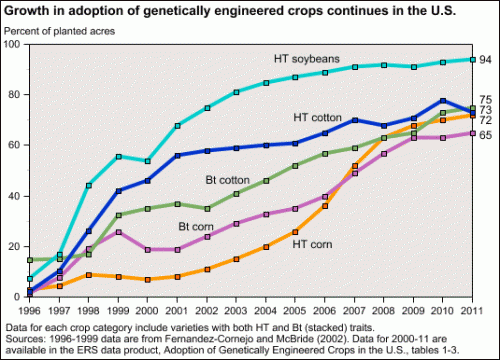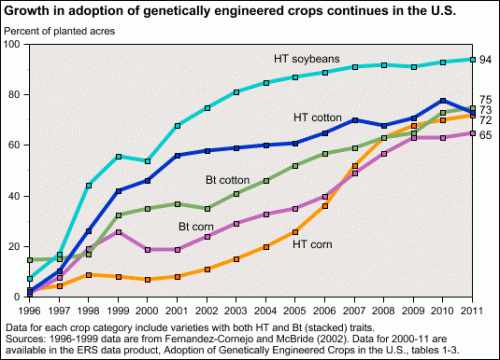The AMA’s strange position on GM foods: test but don’t label
Two queries from readers (see Feedback):
#1: I would love to hear your comments as to why you think the AMA came out in support of “not” labeling GMO foods. Do they have ties to big agriculture or biotech companies? How can they ask for safety testing and then not want the untested products already on the market not labeled? How can we as consumers monitor the effects of GMO’s if they’re not even label? Am I missing something here?
#2: I was also wondering why the American Medical Association would not support labeling genetically engineered foods. This just does not make sense to me. I would love to hear your thoughts on this. Thank you.
I can’t find the AMA statement online but I first read a report about it from Monica Eng in the Chicago Tribune. Fortunately, Rosie Mestel reproduced much of the statement in her account in the Los Angeles Times.
Apparently, AMA delegates said they support mandatory FDA premarket safety assessments of GM foods “as a preventive measure to ensure the health of the public.” They also urge the FDA “to remain alert to new data on the health consequences of bioengineered foods.”
The AMA says that policies on GM foods:
should continue to be science-based and guided by the characteristics of the plant or animal, its intended use, and the environment into which it is to be introduced, not by the method used to produce it, in order to facilitate comprehensive, efficient regulatory review.
And it says,
there is no scientific justification for special labeling of bioengineered foods, as a class, and that voluntary labeling is without value unless it is accompanied by focused consumer education.
Mestel quotes a statement e-mailed to her from AMA board member Dr. Patrice Harris:
The science-based labeling policies of the FDA do not support special product labeling without evidence of material differences between bioengineered foods and their traditional counterparts. The AMA adopted policy supporting this science-based approach, recognizing that there currently is no evidence that there are material differences or safety concerns in available bioengineered foods.
In the first chapter of my book Safe Food: The Politics of Food Safety, I explain what this is about. I distinguish between two approaches to food hazards in general and to GM foods in particular. These are:
- Science-based. Translation: if the food is safe, it is acceptable. GM foods are presumed safe; therefore, they are acceptable and any criticism of them is irrational.
- Value-based. Translation: even if GM foods are safe, they are not necessarily acceptable for reasons of precaution, ethics, religion, culture, or concerns about corporate control of the food supply. Science-based approaches are insufficient; they also need to address such concerns.
The two ways of looking at GM foods are so vastly different that it is hard to know where a compromise might exist. If you have trouble believing this, take a look at the comments on my most recent post on GM foods. These are classic examples of both positions.
The FDA took a strictly science-based approach when it approved GM foods in 1994. The AMA is trying to do the same.
Here’s what surprises me: in recommending premarket safety testing, which is not now required, the AMA appears to be raising serious questions about the safety of GM foods.
If such doubts exist, shouldn’t GM foods be labeled so the public has a choice?
Many value-based concerns about GM foods could be alleviated if the products were labeled. People who didn’t want to buy them wouldn’t have to. Isn’t that what consumer choice is all about?
As I interpret what I’ve seen of the AMA statement, it provides further evidence for the need to label GM foods.
Other countries have no trouble labeling such foods. We could too, and easily, as I have explained previously.
Update, June28: RosieMestel sends the complete AMA policy statement.




